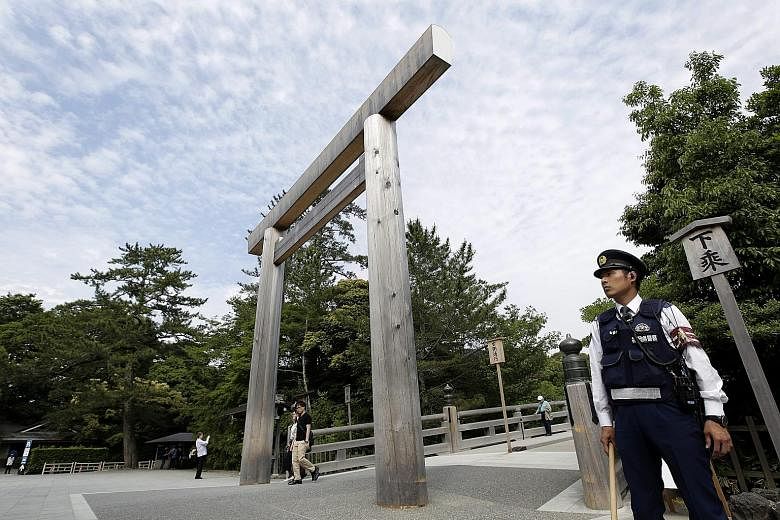TOKYO • In Japan, the Ise Grand Shrine is considered one of the holiest sites in the Shinto religion, a faith whose rituals have been woven into the nation's culture for centuries.
Located more than 300km south-west of Tokyo, the historic complex of wooden buildings set in a deep forest is dedicated to the sun goddess Amaterasu, from whom Japan's emperors are said to be descended.
Ise Jingu, as it is known in Japanese, is also fraught with political meaning this week for Prime Minister Shinzo Abe, who hosts a Group of Seven (G-7) summit on nearby and secluded Kashiko Island in Shima, Mie prefecture.
Despite constitutional restrictions, Mr Abe would like to see the indigenous religion play a more prominent role in Japanese society.
During the May 26-27 G-7 summit, he is expected to take his guests to the shrine, in the latest instance of his promotion of Shintoism.
He has held New Year's press conferences at Ise and, in 2013, was the first premier since 1929 to take part in a rebuilding ceremony held there every 20 years, according to Professor John Breen, a history professor at the International Research Centre for Japanese Studies.
"Abe is much more focused on Shinto than almost any other post-war prime minister," Prof Breen told Bloomberg News.
"He is a key member of Shinto Seiji Renmei, a political association that has as its aim the location of Shinto at the heart of government," he added.
Ise is less controversial than the Yasukuni Shrine in Tokyo, which honours Japan's war dead, including World War II leaders convicted as Class A war criminals.
Visits to Yasukuni by Japanese leaders, including Mr Abe, have sparked anger in China and South Korea, which suffered under Japan's aggression in the first half of the 20th century.
Nevertheless, Mr Abe's 2013 participation in the Ise ceremony drew criticism from Christians in Japan, who said it violated a constitutional ban on the government favouring any particular religion.
For some people in Japan and its neighbouring countries, Shinto is still associated with past nationalism, even though the United States and its allies removed its status as the national religion at the end of the war.
"There's no doubt that Shinto was used by the government during the war," said Mr Katsuji Iwahashi, public relations chief at the Association of Shinto Shrines in Tokyo.
"But is there a religion that has not been used as a reason for fighting? Shrines in themselves are not aggressive."
Ise Shrine employs about 600 people and, according to Diamond business magazine, spent about 55 billion yen (S$693 million) on replacing all its buildings and artefacts in 2013 - the 62nd time it had carried out this ritual.
Its high priests and priestesses are relatives of the imperial family, and past visitors have included Queen Elizabeth II.
This week's summit is the first G-7 meeting in eight years to be held in Asia.
Security measures have been raised to some of the highest levels on land and at sea, reported Yomiuri Shimbun.
Japan will deploy up to 23,000 officers to provide security for the G-7 summit at Mie and the neighbouring prefecture of Aichi.
Security at train stations, airports and facilities that draw large crowds will also be beefed up in Tokyo, Osaka and other cities, reported Jiji Press.
BLOOMBERG

